Implementation of the NHI (Normalized Hot Spot Indices) Algorithm on Infrared ASTER Data: Results and Future Perspectives
Abstract
1. Introduction
2. Data
3. Methods
3.1. NHI Algorithm and its Exportability to ASTER Data
- Conversion from DN to radiance in bands B4 (SWIR1), B5 (SWIR2) and B3N (NIR);
- Data re-projection and resampling, using the nearest neighbor method, to analyze NIR/SWIR data at the same spatial resolution (30 m);
- Gain setting check (see Section 4).
3.2. The AVA Database
4. Results
4.1. Analysis of Kilauea Thermal Activity
4.2. Analysis of Klyuchevskoy Thermal Activity
4.3. Identification of Thermal Anomalies at Shishaldin Volcano
4.4. Investigating Thermal Anomalies at Telica (Nicaragua) Volcano
5. Discussion
6. Conclusions
Author Contributions
Funding
Institutional Review Board Statement
Informed Consent Statement
Data Availability Statement
Acknowledgments
Conflicts of Interest
References
- Harris, A.J.; Butterworth, A.L.; Carlton, R.W.; Downey, I.; Miller, P.; Navarro, P.; Rothery, D.A. Low-cost volcano surveillance from space: Case studies from Etna, Krafla, Cerro Negro, Fogo, Lascar and Erebus. Bull. Volcanol. 1997, 59, 49–64. [Google Scholar] [CrossRef]
- Dean, K.; Servilla, M.; Roach, A.; Foster, B.; Engle, K. Satellite monitoring of remote volcanoes improves study efforts in Alaska. Eos Trans. Am. Geophys. Union 1998, 79, 413–423. [Google Scholar] [CrossRef]
- Kervyn, M.; Ernst, G.G.J.; Harris, A.J.L.; Belton, F.; Mbede, E.; Jacobs, P. Thermal remote sensing of the low-intensity carbonatite volcanism of Oldoinyo Lengai, Tanzania. Int. J. Remote Sens. 2008, 29, 6467–6499. [Google Scholar] [CrossRef]
- Girina, O.A. On precursor of Kamchatkan volcanoes eruptions based on data from satellite monitoring. J. Volcanol. Seismol. 2012, 6, 142–149. [Google Scholar] [CrossRef][Green Version]
- Marchese, F.; Neri, M.; Falconieri, A.; Lacava, T.; Mazzeo, G.; Pergola, N.; Tramutoli, V. The Contribution of Multi-Sensor Infrared Satellite Observations to Monitor Mt. Etna (Italy) Activity during May to August 2016. Remote Sens. 2018, 10, 1948. [Google Scholar] [CrossRef]
- Wright, R.; Flynn, L.; Garbeil, H.; Harris, A.; Pilger, E. Automated volcanic eruption detection using MODIS. Remote Sens. Environ. 2002, 82, 135–155. [Google Scholar] [CrossRef]
- Coppola, D.; Laiolo, M.; Cigolini, C.; Delle Donne, D.; Ripepe, M. Enhanced volcanic hot-spot detection using MODIS IR data: Results from the MIROVA system. Geol. Soc. Lond. Spec. Publ. 2015, 426, 181–205. [Google Scholar] [CrossRef]
- Pergola, N.; Coviello, I.; Filizzola, C.; Lacava, T.; Marchese, F.; Paciello, R.; Tramutoli, V. A review of RSTVOLC, an original algorithm for automatic detection and near-real-time monitoring of volcanic hot spots from space. Geol. Soc. Lond. Spec. Publ. 2015, 426, 55–72. [Google Scholar] [CrossRef]
- Gouhier, M.; Guéhenneux, Y.; Labazuy, P.; Cacault, P.; Decriem, J.; Rivet, S. HOTVOLC: A web-based monitoring system for volcanic hot spots. Geol. Soc. Lond. Spec. Publ. 2016, 426, 223–241. [Google Scholar] [CrossRef]
- Ramsey, M.; Dehn, J. Spaceborne observations of the 2000 Bezymianny, Kamchatka eruption: The integration of high-resolution ASTER data into near real-time monitoring using AVHRR. J. Volcanol. Geotherm. Res. 2004, 135, 127–146. [Google Scholar] [CrossRef]
- Pieri, D.; Abrams, M. ASTER observations of thermal anomalies preceding the April 2003 eruption of Chikurachki volcano, Kurile Islands, Russia. Remote Sens. Environ. 2005, 99, 84–94. [Google Scholar] [CrossRef]
- Reath, K.A.; Ramsey, M.S.; Dehn, J.; Webley, P.W. Predicting eruptions from precursory activity using remote sensing data hybridization. J. Volcanol. Geotherm. Res. 2016, 321, 18–30. [Google Scholar] [CrossRef]
- Reath, K.; Pritchard, M.E.; Moruzzi, S.; Alcott, A.; Coppola, D.; Pieri, D. The AVTOD (ASTER Volcanic Thermal Output Database) Latin America archive. J. Volcanol. Geotherm. Res. 2019, 376, 62–74. [Google Scholar] [CrossRef]
- Abrams, M.; Yamaguchi, Y. Twenty years of ASTER contributions to lithologic mapping and mineral exploration. Remote Sens. 2019, 11, 1394. [Google Scholar] [CrossRef]
- Blackett, M.; Wooster, M.J. Evaluation of SWIR-based methods for quantifying active volcano radiant emissions using NASA EOS-ASTER data. Geomat. Nat. Hazards Risk 2011, 2, 51–78. [Google Scholar] [CrossRef]
- Ramsey, M.S. Synergistic use of satellite thermal detection and science: A decadal perspective using ASTER. Geol. Soc. Lond. Spec. Publ. 2016, 426, 115–136. [Google Scholar] [CrossRef]
- Ramsey, M.S.; Flynn, I.T. The Spatial and Spectral Resolution of ASTER Infrared Image Data: A Paradigm Shift in Volcanological Remote Sensing. Remote Sens. 2020, 12, 738. [Google Scholar] [CrossRef]
- Marchese, F.; Genzano, N.; Neri, M.; Falconieri, A.; Mazzeo, G.; Pergola, N. A Multi-Channel Algorithm for Mapping Volcanic Thermal Anomalies by Means of Sentinel-2 MSI and Landsat-8 OLI Data. Remote Sens. 2019, 11, 2876. [Google Scholar] [CrossRef]
- Genzano, N.; Pergola, N.; Marchese, F. A Google Earth Engine tool to investigate, map and monitor volcanic thermal anomalies at global scale by means of mid-high spatial resolution satellite data. Remote Sens. 2020, 12, 3232. [Google Scholar] [CrossRef]
- Linick, J.P.; Pieri, D.C.; Davies, A.G.; Reath, K.; Mars, J.; Hubbard, B.E.; Sanchez, R.; Tan, H.L. The ASTER Volcano Archive (AVA): High Spatial Resolution Global Monitoring of Volcanic Eruptions. In Proceedings of the American Geophysical Union, Fall Meeting, New Orleans, LA, USA, 11–15 December 2017. [Google Scholar]
- ASTER Volcano Archive (AVA). 2020. Available online: https://ava.jpl.nasa.gov/ (accessed on 18 January 2021).
- Abrams, M.; Hook, S.; Ramachandran, B. ASTER User Handbook; Jet Propulsion Laboratory: Pasadena, CA, USA, 2002; pp. 45–54. [Google Scholar]
- Pieri, D.; Abrams, M. ASTER watches the world’s volcanoes: A new paradigm for volcanological observations from orbit. J. Volcanol. Geotherm. Res. 2004, 135, 13–28. [Google Scholar] [CrossRef]
- Yamaguchi, Y.; Kahle, A.B.; Tsu, H.; Kawakami, T.; Pniel, M. Overview of advanced spaceborne thermal emission and reflection radiometer (ASTER). IEEE Trans. Geosci. Remote Sens. 1998, 36, 1062–1071. [Google Scholar] [CrossRef]
- Wright, R.; Rothery, D.A.; Blake, S.; Harris, A.J.; Pieri, D.C. Simulating the response of the EOS Terra ASTER sensor to high-temperature volcanic targets. Geophys. Res. Lett. 1999, 26, 1773–1776. [Google Scholar] [CrossRef]
- Prakash, A.; Gupta, R.P.; Saraf, A.K. A Landsat TM based comparative study of surface and subsurface fires in the Jharia coalfield, India. Int. J. Remote Sens. 1997, 18, 2463–2469. [Google Scholar] [CrossRef]
- Layana, S.; Aguilera, F.; Rojo, G.; Vergara, Á; Salazar, P.; Quispe, J.; Urra, P.; Urrutia, D. Volcanic Anomalies Monitoring System (VOLCANOMS), a Low-Cost Volcanic Monitoring System Based on Landsat Images. Remote. Sens. 2020, 12, 1589. [Google Scholar] [CrossRef]
- Dennison, P.E.; Matheson, D.S. Comparison of fire temperature and fractional area modeled from SWIR, MIR, and TIR multispectral and SWIR hyperspectral airborne data. Remote Sens. Environ. 2001, 115, 876–886. [Google Scholar] [CrossRef]
- Earth Engine Data Catalogue, ASTER L1T Radiance. Available online: https://developers.google.com/earth-engine/datasets/catalog/ASTER_AST_L1T_003#description (accessed on 9 February 2021).
- Buongiorno, M.F.; Pieri, D.; Silvestri, M. Thermal analysis of volcanoes based on 10 years of ASTER data on Mt. Etna. In Thermal Infrared Remote Sensing; Springer: Dordrecht, Germany, 2013; pp. 409–428. [Google Scholar]
- Lacava, T.; Kervyn, M.; Liuzzi, M.; Marchese, F.; Pergola, N.; Tramutoli, V. Assessing performance of the RSTVOLC multi-temporal algorithm in detecting subtle hot spots at Oldoinyo Lengai (Tanzania, Africa) for comparison with MODLEN. Remote Sens. 2018, 10, 1177. [Google Scholar] [CrossRef]
- Plank, S.; Massimetti, F.; Soldati, A.; Hess, K.U.; Nolde, M.; Martinis, S.; Dingwell, D.B. Estimates of lava discharge rate of 2018 Kīlauea Volcano, Hawaiʻi eruption using multi-sensor satellite and laboratory measurements. Int. J. Remote Sens. 2020, 42, 1492–1511. [Google Scholar] [CrossRef]
- Holland, L.; Businger, S.; Elias, T.; Cherubini, T. Two Ensemble Approaches for Forecasting Sulfur Dioxide Concentrations from Kīlauea Volcano. Weather. Forecast. 2020, 35, 1923–1937. [Google Scholar] [CrossRef]
- USGS, Volcano Hazard Program. Available online: https://volcanoes.usgs.gov/volcanoes/kilauea/archive/multimedia/2005/Feb/main.shtml (accessed on 18 December 2020).
- Global Volcanism Program. Bulletin of the Global Volcanism Network, 31:4; Report on Kilauea (United States); Wunderman, R., Ed.; Smithsonian Institution: Washington, DC, USA, 2006; Available online: https://doi.org/10.5479/si.GVP.BGVN200604-332010 (accessed on 9 February 2021).
- Global Volcanism Program. Report on Kilauea (United States). In Weekly Volcanic Activity Report; Sennert, S.K., Ed.; Smithsonian Institution and US Geological Survey: Reston, VA, USA, 2007. [Google Scholar]
- Poland, M.; Miklius, A.O.; Sutton, T.J.; Thornber, C.; Wilson, D. New Episodes of Volcanism at Kilauea Volcano, Hawaii. Eos Trans. AGU 2008, 89, 37–38. [Google Scholar] [CrossRef]
- Volcano Discovery, Klyuchevskoy Volcano. Available online: https://www.volcanodiscovery.com/it/klyuchevskoy.html (accessed on 16 December 2020).
- Global Volcanism Program. Bulletin of the Global Volcanism Network, 25:9; Report on Klyuchevskoy (Russia); Wunderman, R., Ed.; Smithsonian Institution: Washington, DC, USA, 2000; Available online: https://doi.org/10.5479/si.GVP.BGVN200009-300260 (accessed on 16 December 2020).
- Global Volcanism Program. Bulletin of the Global Volcanism Network, 28:11; Report on Klyuchevskoy, (Russia); Venzke, E., Ed.; Smithsonian Institution: Washington, DC, USA, 2000; Available online: https://doi.org/10.5479/si.GVP.BGVN200311-300260 (accessed on 16 December 2020).
- Global Volcanism Program. Bulletin of the Global Volcanism Network, 29:4; Report on Klyuchevskoy, (Russia); Venzke, E., Ed.; Smithsonian Institution: Washington, DC, USA, 2004; Available online: https://doi.org/10.5479/si.GVP.BGVN200404-300260 (accessed on 16 December 2020).
- Global Volcanism Program. Bulletin of the Global Volcanism Network, 30:3; Report on Klyuchevskoy, (Russia); Wunderman, R., Ed.; Smithsonian Institution: Washington, DC, USA, 2005; Available online: https://doi.org/10.5479/si.GVP.BGVN200503-300260 (accessed on 16 December 2020).
- Global Volcanism Program. Bulletin of the Global Volcanism Network, 32:6; Report on Klyuchevskoy, (Russia); Wunderman, R., Ed.; Smithsonian Institution: Washington, DC, USA, 2007; Available online: https://doi.org/10.5479/si.GVP.BGVN200706-300260 (accessed on 16 December 2020).
- Rose, S.R.; Ramsey, M.S. The 2005 eruption of Kliuchevskoi volcano: Chronology and processes derived from ASTER spaceborne and field-based data. J. Volc. Geotherm. Res. 2009, 184, 367–380. [Google Scholar] [CrossRef]
- Rose, S.R.; Ramsey, M.S. The 2005 and 2007 eruptions of Klyuchevskoy Volcano, Russia: Behavior and effusion mechanisms. In Monitoring Volcanoes in the North Pacific: Observations from Space (suppl. DVD); Dean, K.G., Dehn, J., Eds.; Springer: Heidelberg, Germany, 2015. [Google Scholar]
- Lopez, T.; Clarisse, L.; Schwaiger, H.; Van Eaton, A.; Loewen, M.; Fee, D.; Lyons, J.; Wallace, K.; Searcy, C.; Wech, A.; et al. Constraints on eruption processes and event masses for the 2016–2017 eruption of Bogoslof volcano, Alaska, through evaluation of IASI satellite SO2 masses and complementary datasets. Bull. Volcanol. 2020, 82, 17. [Google Scholar] [CrossRef]
- Global Volcanism Program. Bulletin of the Global Volcanism Network, 25:8; Report on Shishaldin (United, States); Wunderman, R., Ed.; Smithsonian Institution: Washington, DC, USA, 2000; Available online: https://doi.org/10.5479/si.GVP.BGVN200008-311360 (accessed on 16 December 2020).
- Global Volcanism Program. Bulletin of the Global Volcanism Network, 27:5; Report on Shishaldin (United, States); Wunderman, R., Ed.; Smithsonian Institution: Washington, DC, USA, 2002; Available online: https://doi.org/10.5479/si.GVP.BGVN200205-311360 (accessed on 16 December 2020).
- Global Volcanism Program. Bulletin of the Global Volcanism Network, 29:6; Report on Shishaldin (United, States); Wunderman, R., Ed.; Smithsonian Institution: Washington, DC, USA, 2004; Available online: https://doi.org/10.5479/si.GVP.BGVN200406-311360 (accessed on 16 December 2020).
- Global Volcanism Program. Bulletin of the Global Volcanism Network, 33:8; Report on Shishaldin (United, States); Wunderman, R., Ed.; Smithsonian Institution: Washington, DC, USA, 2008; Available online: https://doi.org/10.5479/si.GVP.BGVN200808-311360 (accessed on 16 December 2020).
- Alaska Volcano Observatory. 2001. Available online: https://avo.alaska.edu/volcanoes/activity.php?volcname=shishaldin&eruptionid=523&page=basic (accessed on 16 December 2020).
- Rodgers, M.; Roman, D.C.; Geirsson, H.; LaFemina, P.; McNutt, S.R.; Muñoz, A.; Tenorio, V. Stable and unstable phases of elevated seismic activity at the persistently restless Telica Volcano, Nicaragua. J. Volcanol. Geotherm. Res. 2015, 290, 63–74. [Google Scholar] [CrossRef]
- Ostapenko, S.V.; Spektor, S.V.; Netesov, Y.P. San Jacinto-Tizate geothermal field, Nicaragua: Exploration and conceptual model. Geothermics 1998, 27, 361–378. [Google Scholar] [CrossRef]
- Global Volcanism Program. Bulletin of the Global Volcanism Network, 25:3; Report on Telica, (Nicaragua); Wunderman, R., Ed.; Smithsonian Institution: Washington, DC, USA, 2000; Available online: https://doi.org/10.5479/si.GVP.BGVN200003-344040 (accessed on 16 December 2020).
- Global Volcanism Program. Bulletin of the Global Volcanism Network, 34:5; Report on Telica, (Nicaragua); Wunderman, R., Ed.; Smithsonian Institution: Washington, DC, USA, 2009; Available online: https://doi.org/10.5479/si.GVP.BGVN200905-344040 (accessed on 16 December 2020).
- Global Volcanism Program. Bulletin of the Global Volcanism Network, 34:8; Report on Telica, (Nicaragua); Wunderman, R., Ed.; Smithsonian Institution: Washington, DC, USA, 2009; Available online: https://doi.org/10.5479/si.GVP.BGVN200908-344040 (accessed on 16 December 2020).
- Global Volcanism Program. Bulletin of the Global Volcanism Network, 43:9; Report on Telica, (Nicaragua); Venzke, E., Ed.; Smithsonian Institution: Washington, DC, USA, 2018; Available online: https://doi.org/10.5479/si.GVP.BGVN201809-344040 (accessed on 16 December 2020).
- Abrams, M. The Advanced Spaceborne Thermal Emission and Reflection Radiometer (ASTER): Data products for the high spatial resolution imager on NASA’s Terra platform. Int. J. Remote Sens. 2000, 21, 847–859. [Google Scholar] [CrossRef]
- ASTER Science Office ASTER SWIR Data Status Report. Available online: http://www.aster.jspacesystems.or.jp/en/about_aster/swir_en.pdf (accessed on 1 August 2017).
- Plank, S.; Marchese, F.; Genzano, N. The short life of the volcanic island New Late’iki (Tonga) analyzed by multi-sensor remote sensing data. Sci. Rep. 2020, 10, 22293. [Google Scholar] [CrossRef]
- Trunk, L.; Bernard, A. Investigating crater lake warming using ASTER thermal imagery: Case studies at Ruapehu, Poás, Kawah Ijen, and Copahué Volcanoes. J. Volcanol. Geotherm. Res. 2008, 178, 259–270. [Google Scholar] [CrossRef]
- Carter, A.; Ramsey, M. Long-term volcanic activity at Shiveluch Volcano: Nine years of ASTER spaceborne thermal infrared observations. Remote Sens. 2010, 2, 2571–2583. [Google Scholar] [CrossRef]
- Patrick, M.R.; Witzke, C.N. Thermal mapping of Hawaiian volcanoes with ASTER satellite data. US Geol. Surv. Sci. Investig. Rep. 2011, 5110, 22. [Google Scholar]
- Gray, D.M.; Burton-Johnson, A.; Fretwell, P.T. Evidence for a lava lake on Mt. Michael volcano, Saunders Island (South Sandwich Islands) from Landsat, Sentinel-2 and ASTER satellite imagery. J. Volcanol. Geotherm. Res. 2019, 379, 60–71. [Google Scholar] [CrossRef]
- Lombardo, V.; Buongiorno, M.F. Lava flow thermal analysis using three infrared bands of remote-sensing imagery: A study case from Mount Etna 2001 eruption. Remote Sens. Environ. 2006, 101, 141–149. [Google Scholar] [CrossRef]
- Murphy, S.W.; de Souza Filho, C.R.; Oppenheimer, C. Monitoring volcanic thermal anomalies from space: Size matters. J. Volcanol. Geotherm. Res. 2011, 203, 48–61. [Google Scholar] [CrossRef]
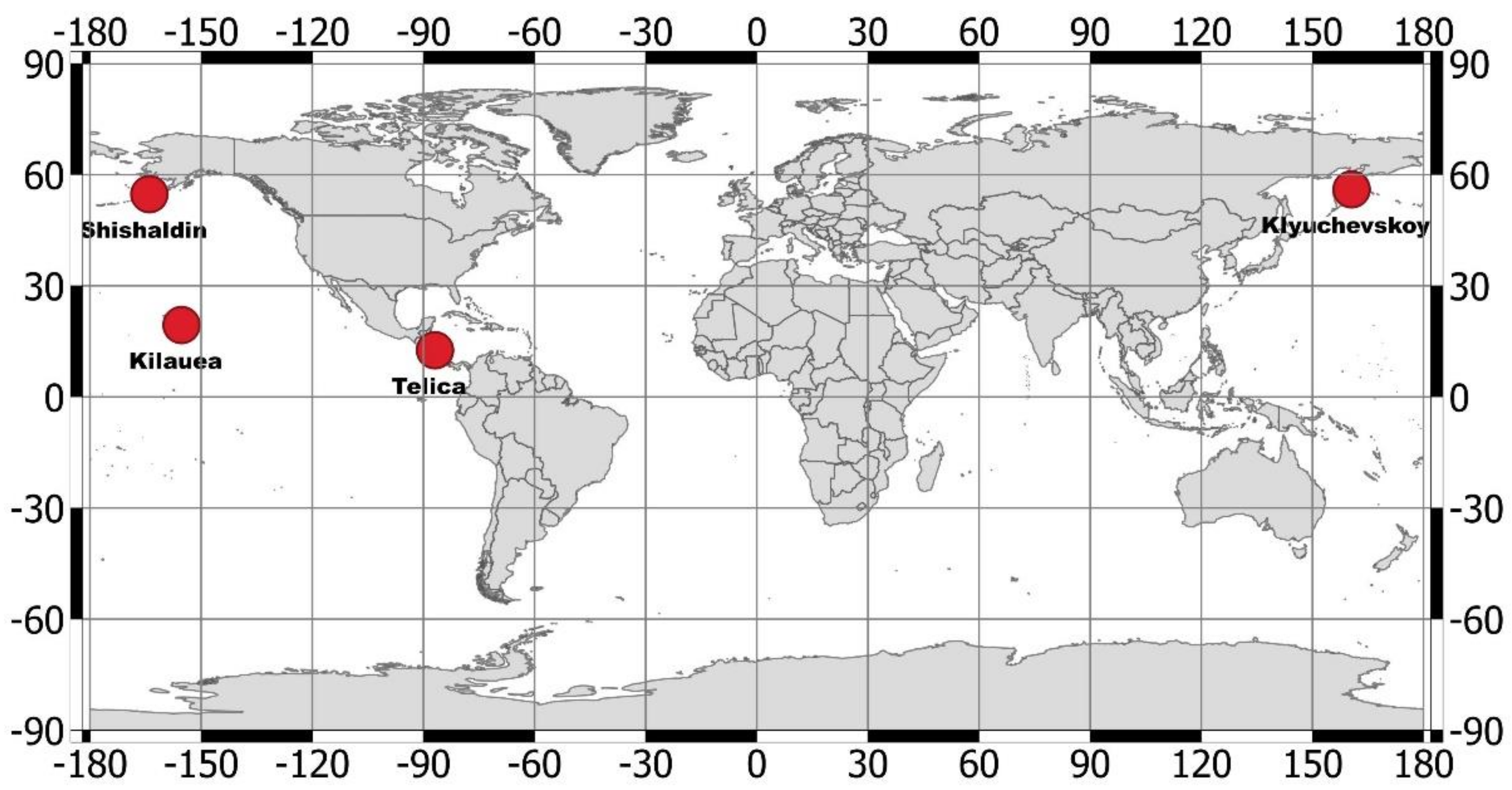
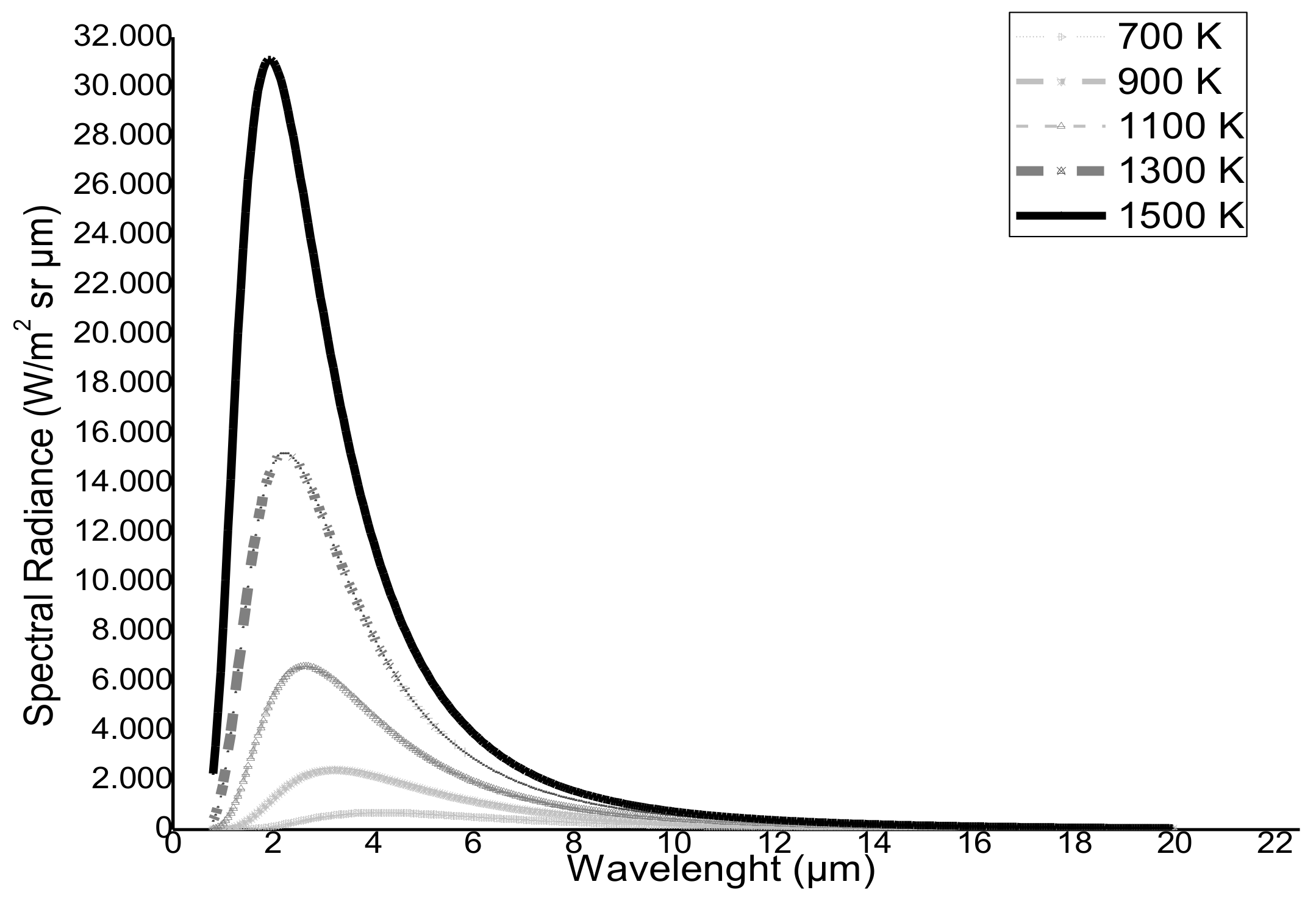
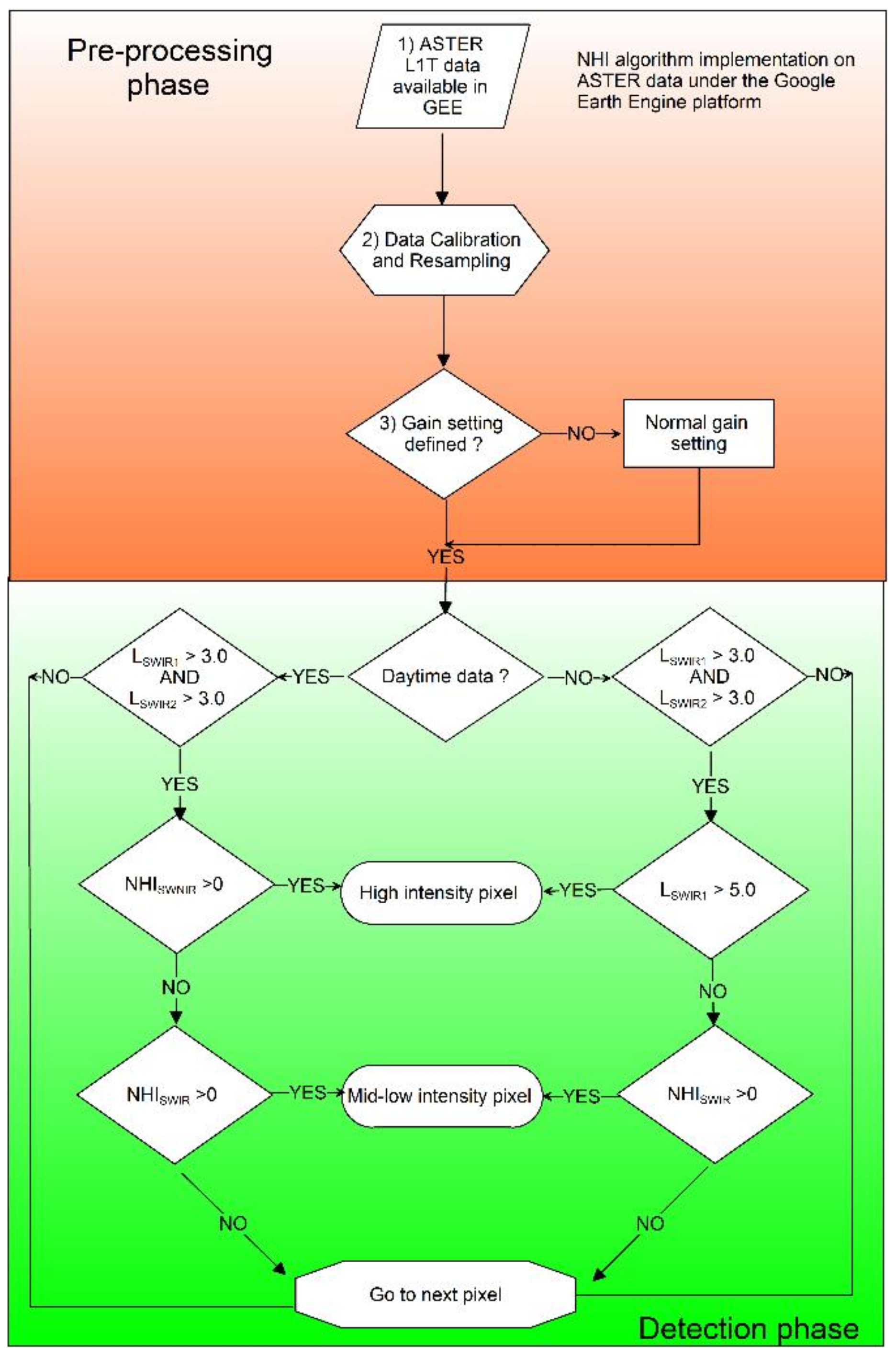
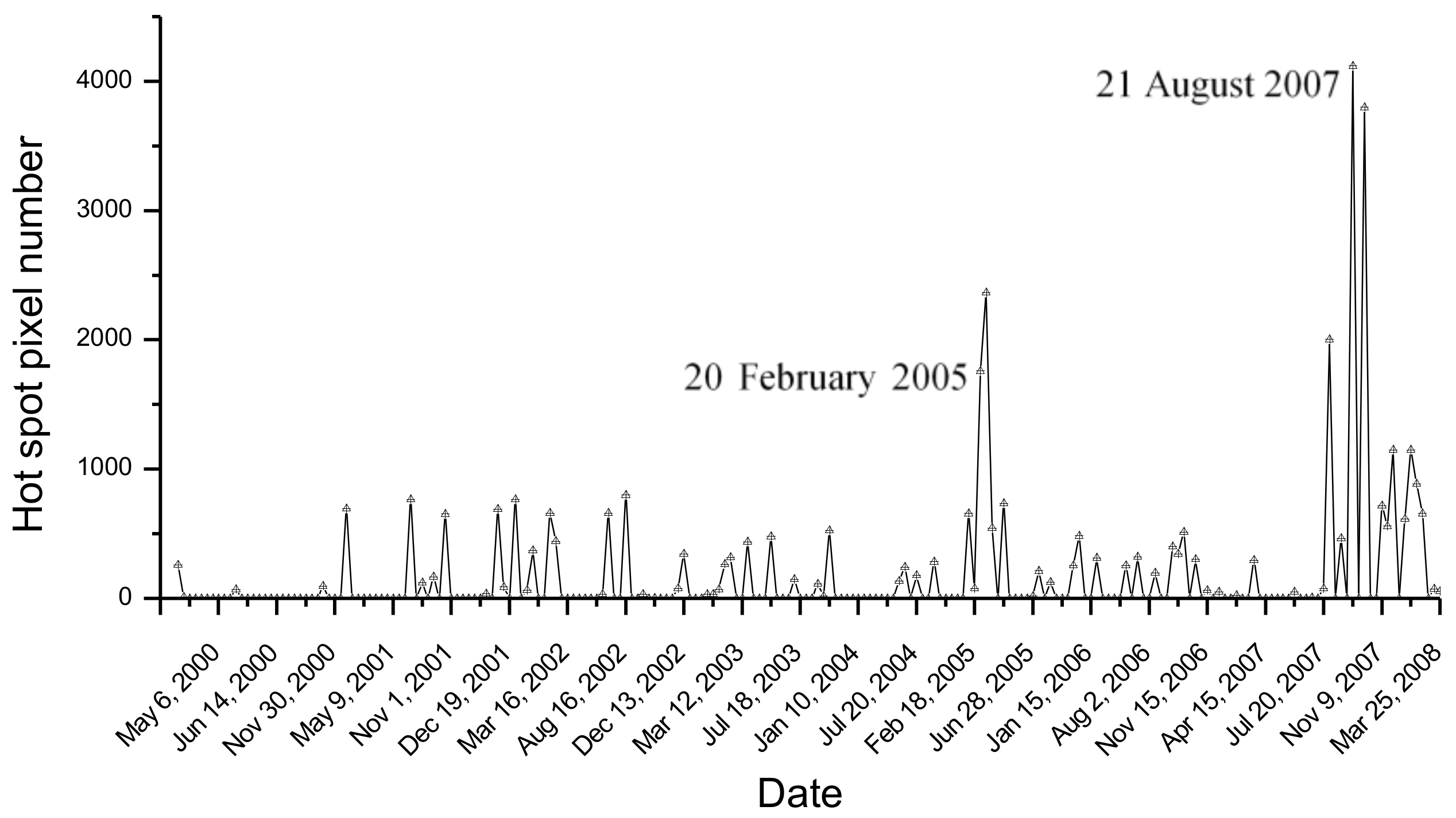
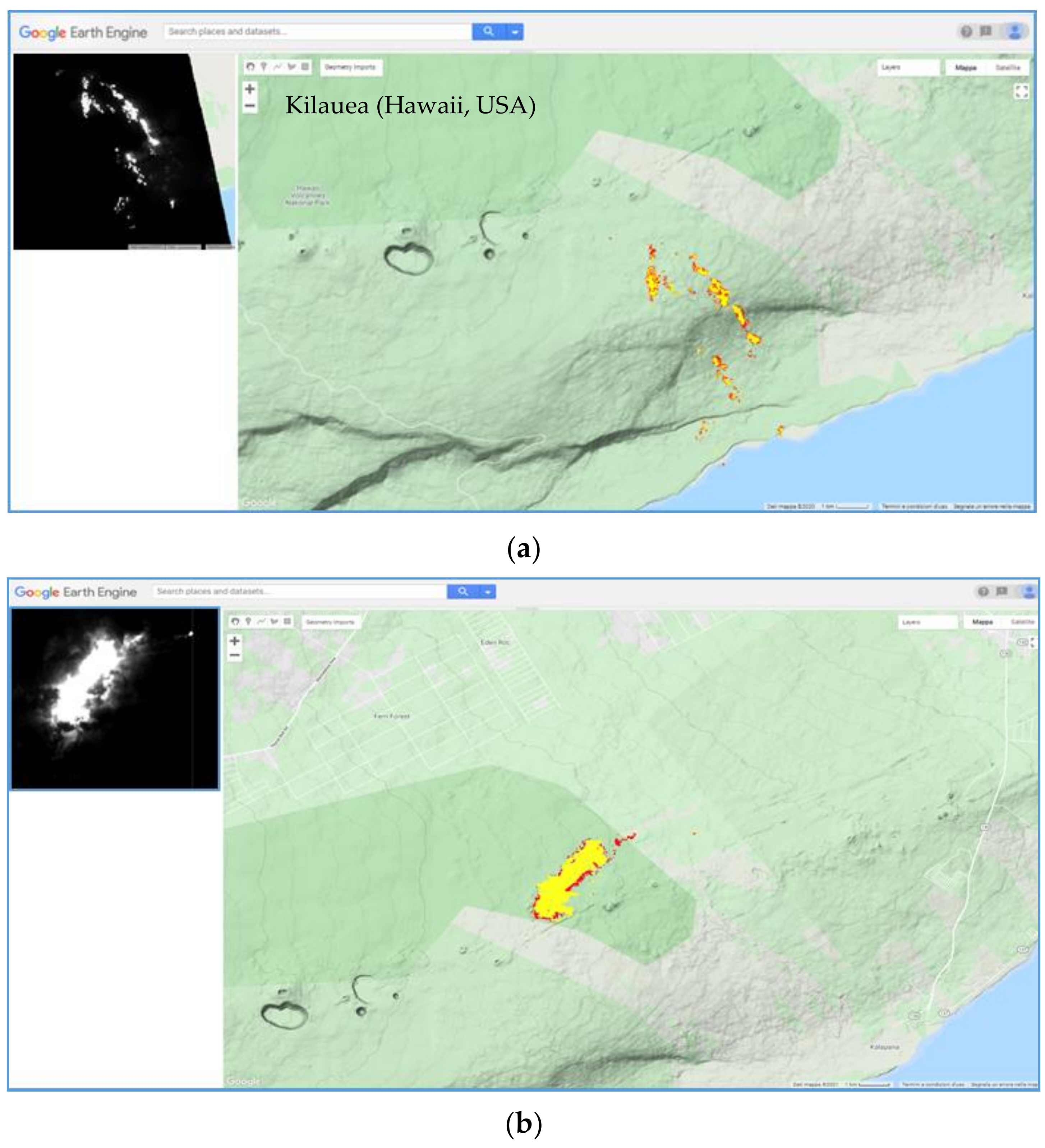
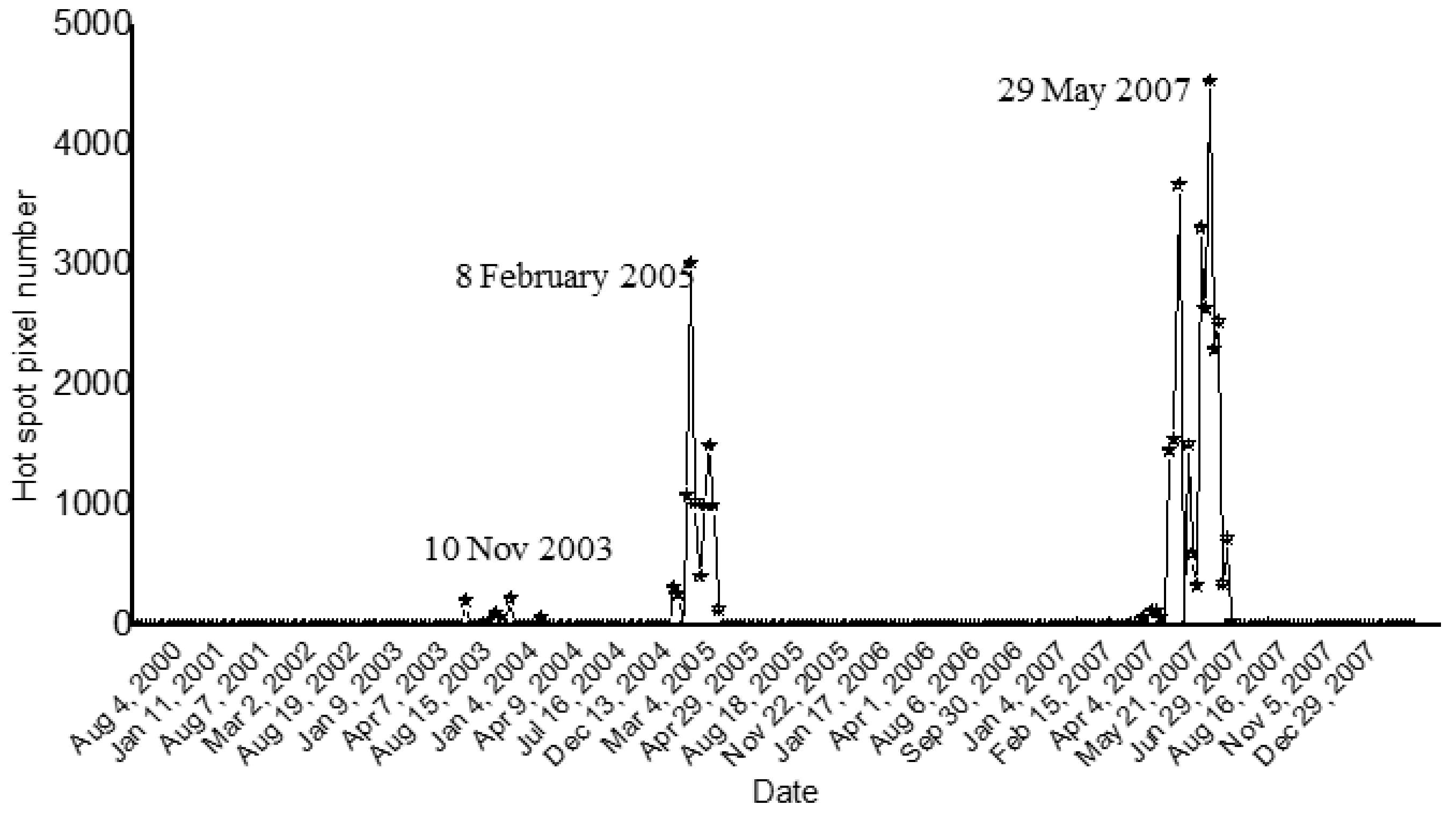
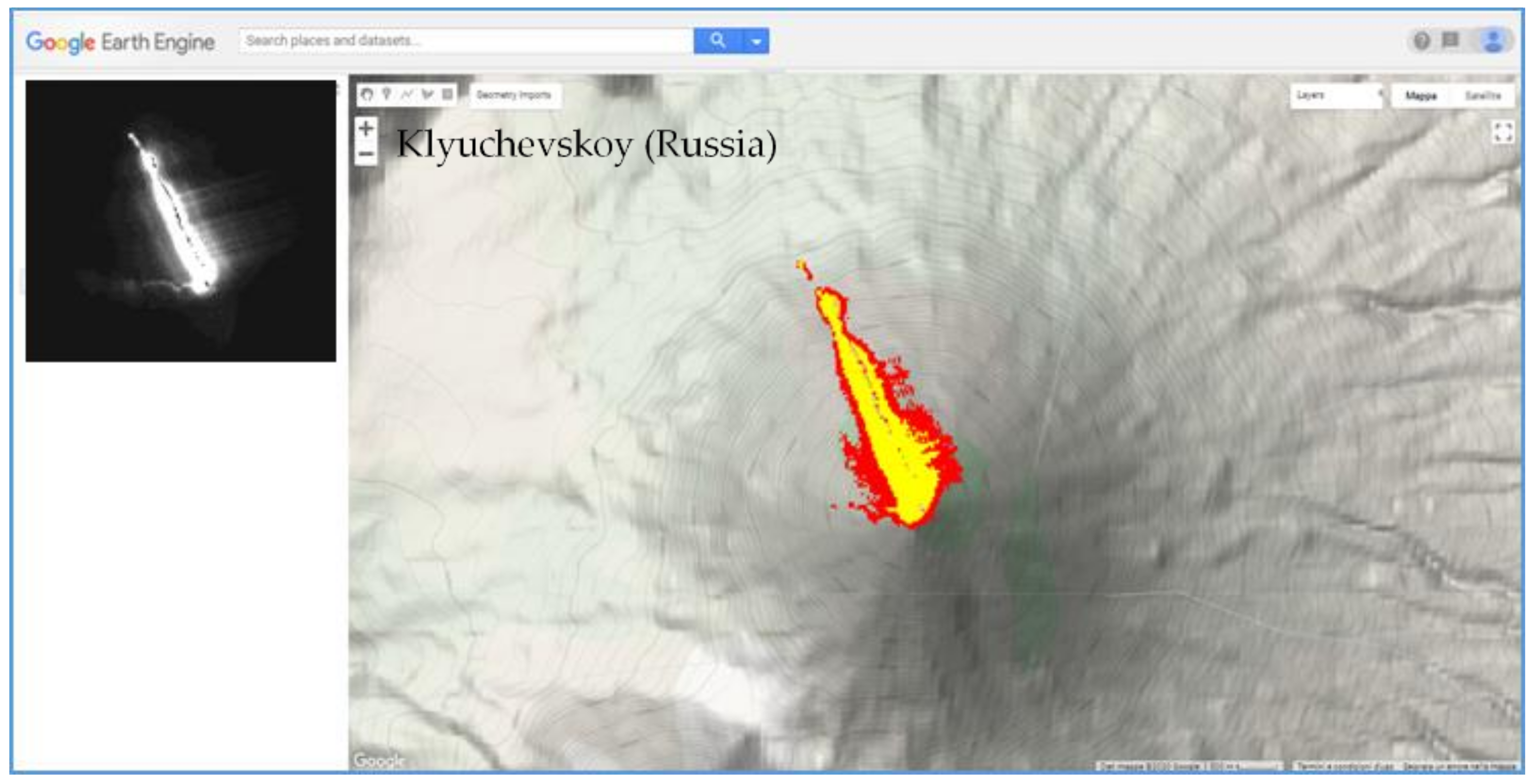
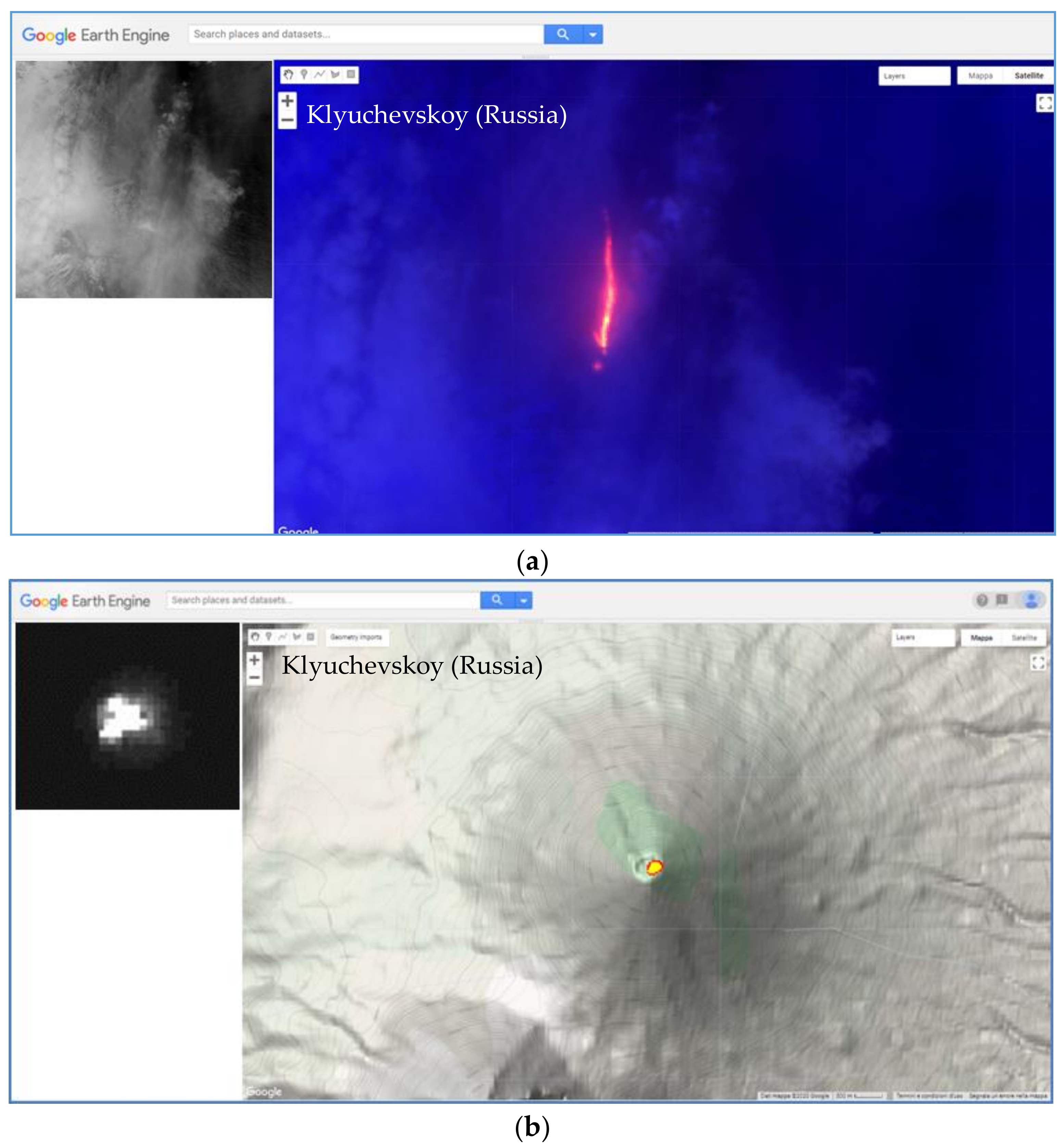
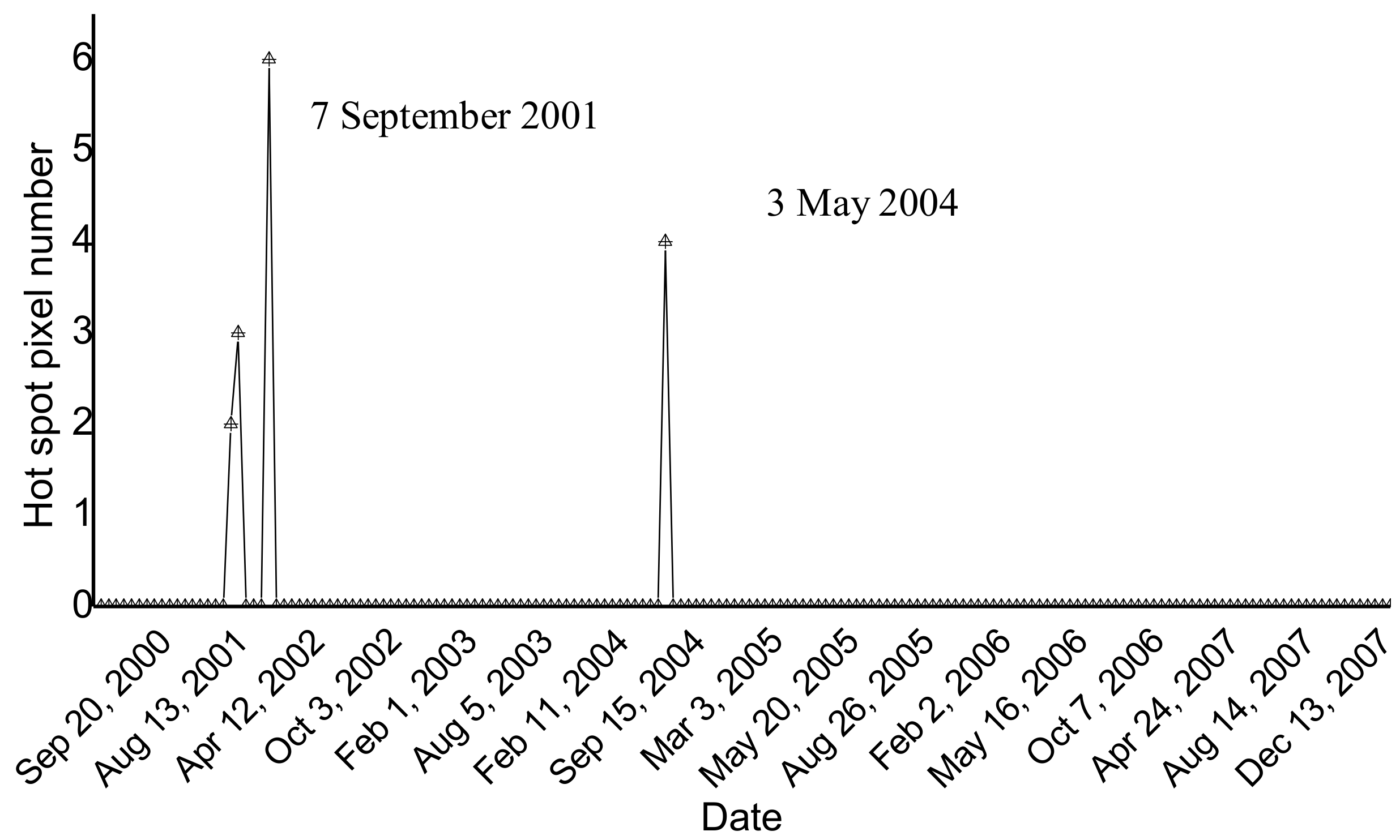

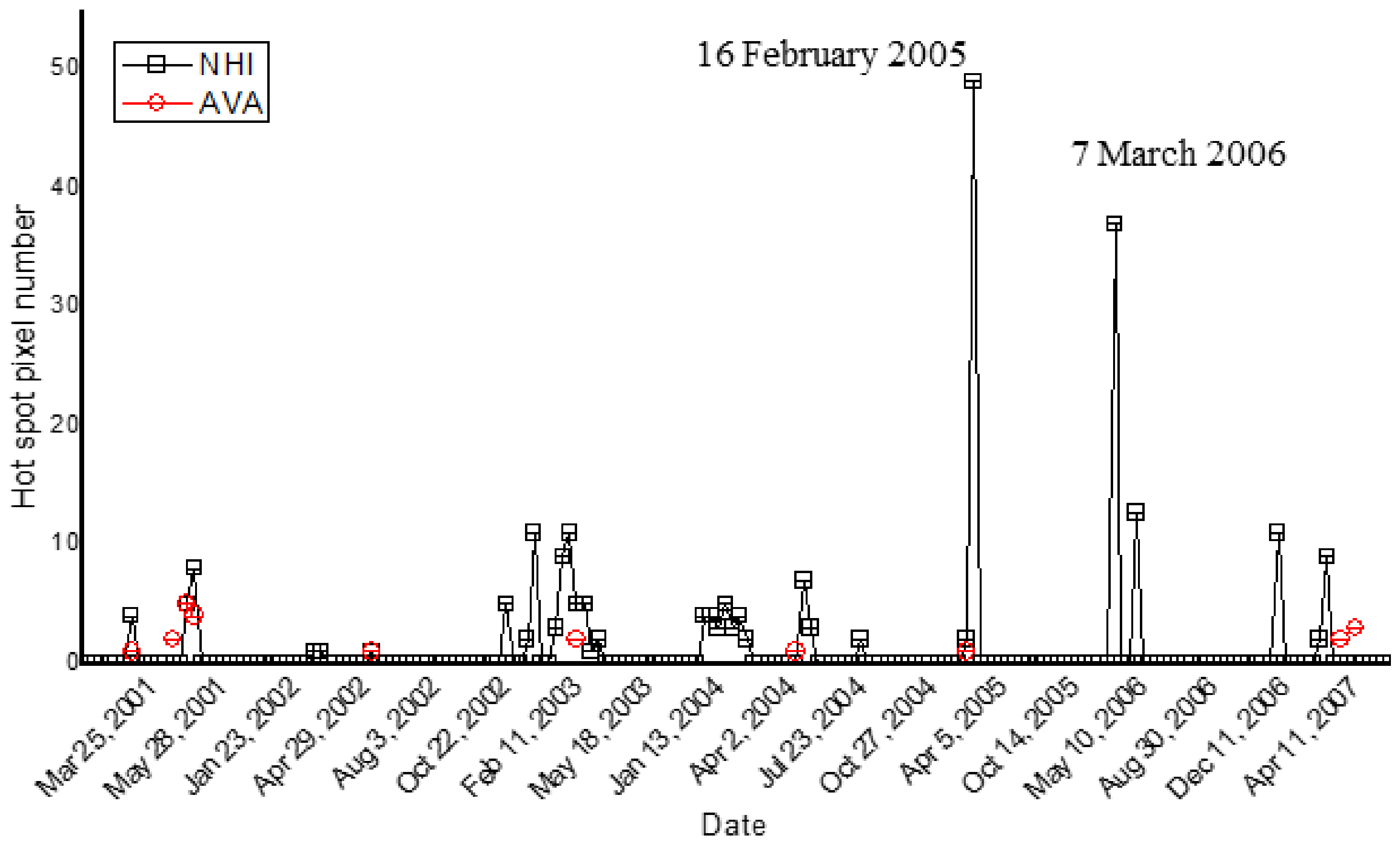
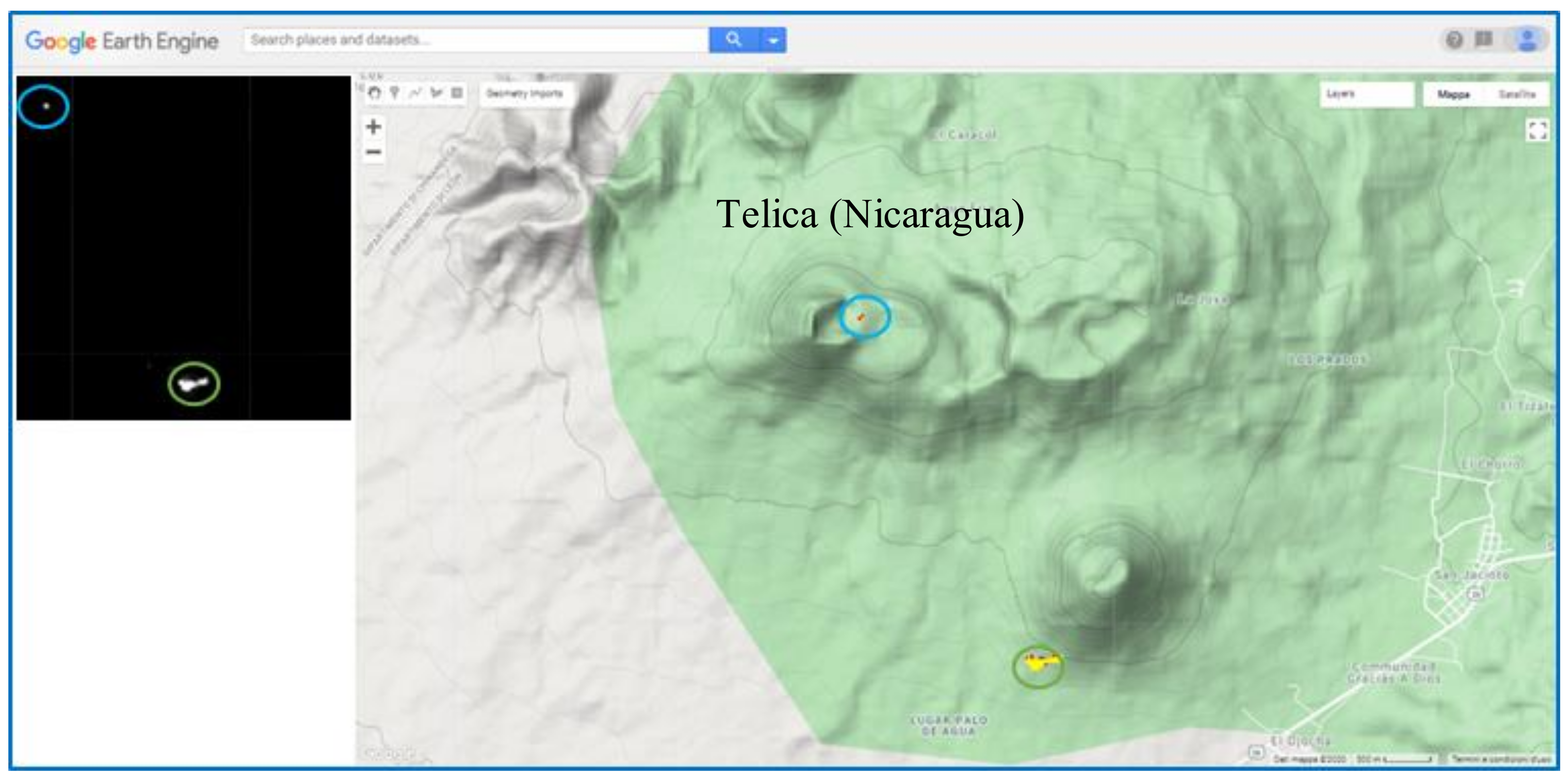
| Band | Spectral Range (μm) | Spatial Resolution (m) | High Gain | Normal Gain | Low Gain 1 | Low Gain 2 |
|---|---|---|---|---|---|---|
| 1 | 0.52–0.60 | 15 | 0.676 | 1.688 | 2.25 | N/A |
| 2 | 0.63–0.69 | 15 | 0.708 | 1.415 | 1.89 | N/A |
| 3N | 0.78–0.86 | 15 | 0.423 | 0.862 | 1.15 | N/A |
| 3B | 0.78–0.86 | 15 | 0.423 | 0.862 | 1.15 | N/A |
| 4 | 1.60–1.70 | 30 | 0.1087 | 0.2174 | 0.290 | 0.290 |
| 5 | 2.145–2.185 | 30 | 0.0348 | 0.0696 | 0.0925 | 0.409 |
| 6 | 2.185–2.225 | 30 | 0.0313 | 0.0625 | 0.0830 | 0.390 |
| 7 | 2.235–2.285 | 30 | 0.0299 | 0.0597 | 0.0795 | 0.332 |
| 8 | 2.295–2.365 | 30 | 0.0209 | 0.0417 | 0.0556 | 0.245 |
| 9 | 2.360–2.430 | 30 | 0.0159 | 0.0318 | 0.0424 | 0.265 |
| 10 | 8.125–8.475 | 30 | N/A | 6.82 × 10−3 | N/A | N/A |
| 11 | 8.475–8.825 | 30 | N/A | 6.78 × 10−3 | N/A | N/A |
| 12 | 8.925–9.275 | 90 | N/A | 6.59 × 10−3 | N/A | N/A |
| 13 | 10.25–10.95 | 90 | N/A | 5.69 × 10−3 | N/A | N/A |
| 14 | 10.95–11.65 | 90 | N/A | 5.22 × 10−3 | N/A | N/A |
| Volcano | Number of ASTER Images with Detected Thermal Anomalies | Unique Detections | ||
|---|---|---|---|---|
| NHI | AVA | NHI | AVA | |
| Kilauea | 80 | 87 | 8.8% | 16.1% |
| Klyuvcheskoy | 45 | 44 | 15.6% | 13.,6% |
| Telica | 37 | 5 | 86.5% | 20.0% |
| Shishaldin | 4 | 0 | 100% | 00% |
Publisher’s Note: MDPI stays neutral with regard to jurisdictional claims in published maps and institutional affiliations. |
© 2021 by the authors. Licensee MDPI, Basel, Switzerland. This article is an open access article distributed under the terms and conditions of the Creative Commons Attribution (CC BY) license (http://creativecommons.org/licenses/by/4.0/).
Share and Cite
Mazzeo, G.; Ramsey, M.S.; Marchese, F.; Genzano, N.; Pergola, N. Implementation of the NHI (Normalized Hot Spot Indices) Algorithm on Infrared ASTER Data: Results and Future Perspectives. Sensors 2021, 21, 1538. https://doi.org/10.3390/s21041538
Mazzeo G, Ramsey MS, Marchese F, Genzano N, Pergola N. Implementation of the NHI (Normalized Hot Spot Indices) Algorithm on Infrared ASTER Data: Results and Future Perspectives. Sensors. 2021; 21(4):1538. https://doi.org/10.3390/s21041538
Chicago/Turabian StyleMazzeo, Giuseppe, Micheal S. Ramsey, Francesco Marchese, Nicola Genzano, and Nicola Pergola. 2021. "Implementation of the NHI (Normalized Hot Spot Indices) Algorithm on Infrared ASTER Data: Results and Future Perspectives" Sensors 21, no. 4: 1538. https://doi.org/10.3390/s21041538
APA StyleMazzeo, G., Ramsey, M. S., Marchese, F., Genzano, N., & Pergola, N. (2021). Implementation of the NHI (Normalized Hot Spot Indices) Algorithm on Infrared ASTER Data: Results and Future Perspectives. Sensors, 21(4), 1538. https://doi.org/10.3390/s21041538









